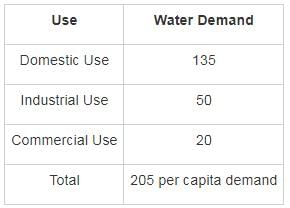All Exams >
Civil Engineering (CE) >
RRB JE for Civil Engineering >
All Questions
All questions of Environmental Engineering for Civil Engineering (CE) Exam
The ultimate BOD value of a waste -- a)increase with temperature.
- b)decreases with temperature.
- c)remains the same at all temperatures.
- d)doubles with every 10°c rise in temperature.
Correct answer is option 'C'. Can you explain this answer?
The ultimate BOD value of a waste -
a)
increase with temperature.
b)
decreases with temperature.
c)
remains the same at all temperatures.
d)
doubles with every 10°c rise in temperature.

|
Puja Sharma answered |
The ultimate BOD value of waste is the amount of biodegradable organic matter presents in the sewage sample. At any temperature the amount of organic matter present does not change, so the ultimate BOD will remain same for any temperature.
The Maximum velocity through a circular channel takes place when the depth of flow is equal to:- a)0.95 times the diameter
- b)0.5 times the diameter
- c)0.81 times the diameter
- d)0.3 times the diameter
Correct answer is option 'C'. Can you explain this answer?
The Maximum velocity through a circular channel takes place when the depth of flow is equal to:
a)
0.95 times the diameter
b)
0.5 times the diameter
c)
0.81 times the diameter
d)
0.3 times the diameter

|
Jithin Choudhury answered |
Maximum velocity occurs at 0.81 times the diameter and maximum discharge occurs at 0.95 times the diameter.
As per IS 10500:2012, the total concentration of manganese (as Mn) and iron (as Fe) for drinking water purpose shall not exceed - a)0.1 mg/L
- b)0.2 mg/L
- c)0.3 mg/L
- d)0.5 mg/L
Correct answer is option 'C'. Can you explain this answer?
As per IS 10500:2012, the total concentration of manganese (as Mn) and iron (as Fe) for drinking water purpose shall not exceed
a)
0.1 mg/L
b)
0.2 mg/L
c)
0.3 mg/L
d)
0.5 mg/L

|
Neha Mukherjee answered |
As per IS10500:2012, the total concentration of manganese (as Mn) and iron (as Fe) for drinking water purpose shall not exceed 0.3 mg/L.
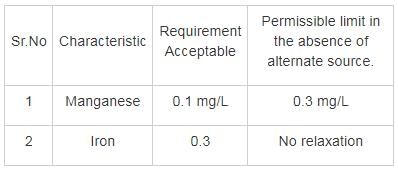

The maximum efficiency of BOD removal is achieved in which of the following?- a)Oxidation ditch
- b)Oxidation ponds
- c)Aerated lagoons
- d)Trickling filter
Correct answer is option 'A'. Can you explain this answer?
The maximum efficiency of BOD removal is achieved in which of the following?
a)
Oxidation ditch
b)
Oxidation ponds
c)
Aerated lagoons
d)
Trickling filter

|
Anirudh Kulkarni answered |
The main advantage of oxidation ditch is the ability to achieve removal performance objective with low operational requirements and eminence costs.An oxidation ditch is a modified activated sludge biological treatment process that uses long solids retention times (SRTs) to remove biodegradable organics. The typical oxidation ditch is equipped with aeration rotors or brushes that provide aeration and circulation. The wastewater moves through the ditch at 1 to 2ft/s. The ditch may be designed for continuous or intermittent operation. Because of this feature, this process may be adaptable to the fluctuations in flows and loadings associated with recreation area wastewater production. Several manufacturers have developed modifications to the oxidation ditch design to remove nutrients in conditions cycled or phased between the anoxic and aerobic states.
Oxidation ponds, also called lagoons or stabilization ponds, are large, shallow ponds designed to treat wastewater through the interaction of sunlight bacteria, and algae. Algae grow using energy from the sun and carbon dioxide and inorganic compounds released by bacteria in water. During the process of photosynthesis, the algae release oxygen needed by aerobic bacteria. Mechanical aerators are sometimes installed to supply yet more oxygen, thereby reducing the required size of the pond. Sludge deposits in the pond must eventually be removed by dredging. Algae remaining in the pond effluent can be removed by filtration or by a combination of chemical treatment and settling.
A watershed of area 90 hectare has a runoff coefficient of 0.4. A storm of duration larger than the time of concentration of the watershed and of intensity 4.5 cm/h creates a peak discharge of- a)11.3 m3/s
- b)0.45 m3/s
- c)450 m3/s
- d)4.5 m3/s
Correct answer is option 'D'. Can you explain this answer?
A watershed of area 90 hectare has a runoff coefficient of 0.4. A storm of duration larger than the time of concentration of the watershed and of intensity 4.5 cm/h creates a peak discharge of
a)
11.3 m3/s
b)
0.45 m3/s
c)
450 m3/s
d)
4.5 m3/s

|
Partho Jain answered |
Peak flood by rational formula is given by QP = 136 KPcA
Where, K = Co-efficient of run off; pc = intensity (cm/hr); A = area in hectare

Where, K = Co-efficient of run off; pc = intensity (cm/hr); A = area in hectare

A water sample analysis produces alkalinity and total hardness of 200 mg/L and 250 mg/L as CaCO3 respectively. The carbonate and non-carbonate hardness (as CaCO3) will respectively be- a)200 mg/L and 50 mg/L
- b)200 mg/L and 0 mg/L
- c)250 mg/L and 50 mg/L
- d)250 mg/L and 0 mg/L
Correct answer is option 'A'. Can you explain this answer?
A water sample analysis produces alkalinity and total hardness of 200 mg/L and 250 mg/L as CaCO3 respectively. The carbonate and non-carbonate hardness (as CaCO3) will respectively be
a)
200 mg/L and 50 mg/L
b)
200 mg/L and 0 mg/L
c)
250 mg/L and 50 mg/L
d)
250 mg/L and 0 mg/L
|
|
Lavanya Menon answered |
Concept:
Carbonate hardness = minimum of {Alkalinity, Total Hardness}
Total hardness = Carbonate Hardness + Non-carbonate Hardness.
Calculation:
Carbonate Hardness= minimum of {200 mg/L , 250 mg/L}
Carbonate Hardness = 200 mg/L as CaCO3
Non-Carbonate Hardness = Total Hardness – Carbonate Hardness
= 250 – 200
= 50 mg/L as CaCO3
Which one of the following related to domestic potable water quality is CORRECT?- a)Turbidity (on Silica scale) is 15-20 ppm
- b)Colour (on Cobalt scale) is 15-25 ppm
- c)Hardness (expressed as CaCO3 equivalent) is 75-115 ppm
- d)BOD is 20 ppm
Correct answer is option 'C'. Can you explain this answer?
Which one of the following related to domestic potable water quality is CORRECT?
a)
Turbidity (on Silica scale) is 15-20 ppm
b)
Colour (on Cobalt scale) is 15-25 ppm
c)
Hardness (expressed as CaCO3 equivalent) is 75-115 ppm
d)
BOD is 20 ppm

|
Subhankar Khanna answered |
Portable water quality parameter

(c) Hardness ϵ (75 to 115) ppm
(d) BOD = 0 ppm

(c) Hardness ϵ (75 to 115) ppm
(d) BOD = 0 ppm
1 TCU is equivalent to the color produced by- a)1 mg/L of chloroplatinate ion
- b)1 mg/L of platinum ion
- c)1 mg/L of platinum in form of chloroplatinate ion
- d) mg/L of chlorine in the form of chloroplatinate ion.
Correct answer is option 'C'. Can you explain this answer?
1 TCU is equivalent to the color produced by
a)
1 mg/L of chloroplatinate ion
b)
1 mg/L of platinum ion
c)
1 mg/L of platinum in form of chloroplatinate ion
d)
mg/L of chlorine in the form of chloroplatinate ion.

|
Aditi Chakraborty answered |
TCU represent the true colour unit. It is a unit to represent colour impurities in water. 1 TCU is equivalent to the colour produced by 1 mg/L of platinum in form of chloroplatinate ion.
Two primary air pollutants are- a)Sulfur oxide and ozone
- b)Nitrogen oxide and Peroxyacetylnitrate
- c)Sulphur oxide and hydrocarbon
- d)Ozone and Peroxyacetylnitrate
Correct answer is option 'C'. Can you explain this answer?
Two primary air pollutants are
a)
Sulfur oxide and ozone
b)
Nitrogen oxide and Peroxyacetylnitrate
c)
Sulphur oxide and hydrocarbon
d)
Ozone and Peroxyacetylnitrate

|
Aarav Chauhan answered |
Sulphur dioxide carbon monoxide, nitrogen oxides, lead, hydrocarbons, allergic agents like pollens and spores and radioactive substances are primary pollutants. Sulphuric acid, ozone, formaldehydes & peroxyacylnitrates (PAN) are secondary pollutants.
The design parameter for flocculation is given by a dimensionless number Gt, where G is the velocity gradient and t is the detention time. Values of Gt ranging from 104 to 105 are commonly used, with t ranging from 10 to 30 min. the most preferred combination of G and t to produce smaller and denser flocs is- a)Large G values with short t
- b)Large G values with long t
- c)Small G values with short t
- d)Small G values with long t
Correct answer is option 'A'. Can you explain this answer?
The design parameter for flocculation is given by a dimensionless number Gt, where G is the velocity gradient and t is the detention time. Values of Gt ranging from 104 to 105 are commonly used, with t ranging from 10 to 30 min. the most preferred combination of G and t to produce smaller and denser flocs is
a)
Large G values with short t
b)
Large G values with long t
c)
Small G values with short t
d)
Small G values with long t

|
Lakshmi Datta answered |
Large G values with short times tend to produce small, dense flocs, while low G values and long times produce large, lighter flocs. Since large, dense flocs are more easily removed in the settling basin, it may be advantageous to vary the G values over the length of the flocculation basin. The small dense flocs produced at high G values subsequently combine into larger flocs at the lower G values. Reduction in G values by a factor of 2 from the influent end to the effluent end of the flocculator has been shown to be effective.
A channel-type grit chamber has a flow-through velocity of 0.15 m/s, a depth of 0.8 m and a length of 10 m. For inorganic particles with the specific gravity of 2.7, and considering kinematic viscosity of 8×10-7 m2/s the largest diameter that can be removed with 95% efficiency is- a)0.0452 mm
- b)0.0786 mm
- c)0.0873 mm
- d)0.0992 mm
Correct answer is option 'D'. Can you explain this answer?
A channel-type grit chamber has a flow-through velocity of 0.15 m/s, a depth of 0.8 m and a length of 10 m. For inorganic particles with the specific gravity of 2.7, and considering kinematic viscosity of 8×10-7 m2/s the largest diameter that can be removed with 95% efficiency is
a)
0.0452 mm
b)
0.0786 mm
c)
0.0873 mm
d)
0.0992 mm

|
Bhaskar Unni answered |
The settling velocity can be determined through the equation,

where H = depth of the tank, L = length of the tank, Vs = Settling velocity, and VH = Flow through velocity

Now, using Stokes law,


where H = depth of the tank, L = length of the tank, Vs = Settling velocity, and VH = Flow through velocity

Now, using Stokes law,

where G = specific gravity of the particle, ν =kinematic viscosity of the particle, g = acceleration due to gravity, d = diameter of the particle
For 95% removal efficiency,
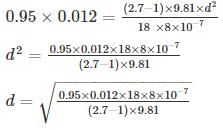
d = 9.92 × 10−5m
d = 0.0992.mm

d = 9.92 × 10−5m
d = 0.0992.mm
What would be the concentration of returned sludge (in mg/l) if the sludge volume index for an activated sludge is 92 ml per gm
Correct answer is between '10869,10870'. Can you explain this answer?
What would be the concentration of returned sludge (in mg/l) if the sludge volume index for an activated sludge is 92 ml per gm

|
Nilanjan Chawla answered |
Concentration of returned sludge =

= 10869.56 mg/l
Which of the following engineering system for air pollution control device can collect a particle size of less than one micrometer and can also have an efficiency as high as 99%- a)Centrifugal Collector
- b)Electrostatic Precipitator
- c)Fabric Filtration
- d)Cyclonic Wet Collector
Correct answer is option 'C'. Can you explain this answer?
Which of the following engineering system for air pollution control device can collect a particle size of less than one micrometer and can also have an efficiency as high as 99%
a)
Centrifugal Collector
b)
Electrostatic Precipitator
c)
Fabric Filtration
d)
Cyclonic Wet Collector

|
Sagnik Sen answered |
Fabric Filtration
Fabric filtration is an engineering system for air pollution control that can collect particles as small as less than one micrometer in size with an efficiency as high as 99%. Here's why fabric filtration is the correct choice for this scenario:
Efficiency
- Fabric filtration systems are known for their high efficiency in capturing particles of various sizes, including ultra-fine particles smaller than one micrometer.
- The fabric filters have a high collection efficiency, often reaching up to 99% or more, making them extremely effective at removing pollutants from the air.
Particle Size Collection
- Fabric filters are designed with a dense network of fibers that can capture particles as small as less than one micrometer.
- The small spaces between the fibers create a barrier that effectively traps even the tiniest particles, ensuring thorough air filtration.
Versatility
- Fabric filtration systems can be customized to suit different air pollution control needs and can be used in various industries and applications.
- They can handle a wide range of particle sizes and can be designed to target specific pollutants based on the requirements of the air quality standards.
Conclusion
In conclusion, fabric filtration is a reliable engineering system for air pollution control that can effectively collect particles smaller than one micrometer with a high efficiency of up to 99%. Its versatility, efficiency, and ability to capture ultra-fine particles make it a suitable choice for addressing air pollution challenges.
Pollution potential of domestic sewage generated in a town and its industrial sewage can be compared with reference to- a)their BOD value
- b)population equivalent
- c)their volume
- d)the relative density
Correct answer is option 'B'. Can you explain this answer?
Pollution potential of domestic sewage generated in a town and its industrial sewage can be compared with reference to
a)
their BOD value
b)
population equivalent
c)
their volume
d)
the relative density

|
Jyoti Choudhury answered |
Understanding Pollution Potential of Sewage
When comparing the pollution potential of domestic sewage generated in a town to that of industrial sewage, using the population equivalent is the most effective approach. Here's why:
Population Equivalent Explained
- The population equivalent (PE) is a measure that equates the pollutant load of industrial sewage to the load produced by a certain number of people in a community.
- It provides a standardized way to assess the impact of different types of sewage on the environment, allowing for a more accurate comparison.
Why Not Other Options?
- BOD Value: While Biochemical Oxygen Demand (BOD) is important for measuring organic pollutants, it does not account for the volume or specific characteristics of industrial effluents.
- Volume: The volume of sewage does not directly correlate with its pollution potential. Different types of sewage can have vastly different pollutant concentrations, rendering volume alone insufficient for comparison.
- Relative Density: This factor mainly addresses the physical characteristics of sewage rather than its biological or chemical potential to cause pollution.
Conclusion
Using population equivalent allows for a comprehensive and comparable assessment of pollution potential from domestic and industrial sources. It incorporates both the quantity and quality of sewage, making it a crucial metric for environmental engineers and policymakers.
When comparing the pollution potential of domestic sewage generated in a town to that of industrial sewage, using the population equivalent is the most effective approach. Here's why:
Population Equivalent Explained
- The population equivalent (PE) is a measure that equates the pollutant load of industrial sewage to the load produced by a certain number of people in a community.
- It provides a standardized way to assess the impact of different types of sewage on the environment, allowing for a more accurate comparison.
Why Not Other Options?
- BOD Value: While Biochemical Oxygen Demand (BOD) is important for measuring organic pollutants, it does not account for the volume or specific characteristics of industrial effluents.
- Volume: The volume of sewage does not directly correlate with its pollution potential. Different types of sewage can have vastly different pollutant concentrations, rendering volume alone insufficient for comparison.
- Relative Density: This factor mainly addresses the physical characteristics of sewage rather than its biological or chemical potential to cause pollution.
Conclusion
Using population equivalent allows for a comprehensive and comparable assessment of pollution potential from domestic and industrial sources. It incorporates both the quantity and quality of sewage, making it a crucial metric for environmental engineers and policymakers.
The ultimate BOD of wastewater is 300 mg/L and the reaction rate constant (to the base ‘e’) at 20°C is 0.3585/day, then the 5 days BOD at 20oC will be.- a)175 mg/L
- b)50 mg/L
- c)250 mg/L
- d)200 mg/L
Correct answer is option 'C'. Can you explain this answer?
The ultimate BOD of wastewater is 300 mg/L and the reaction rate constant (to the base ‘e’) at 20°C is 0.3585/day, then the 5 days BOD at 20oC will be.
a)
175 mg/L
b)
50 mg/L
c)
250 mg/L
d)
200 mg/L

|
Sarthak Kulkarni answered |
Concept:
Ultimate BOD = Lo
BOD5 = 5day BOD, of water/waste water
BOD at any time ‘t’ is (Lt)
Lt = Lo(1 − e−kDt)
Lt = Lo(1 − e−kDt)
Where Lo = ultimate BOD
KD = Rate constant
Calculation:
Lt = 300 × (1 – e-0.3585 × t)
L5 = BOD5 = 300 × (1 – e-0.3585 × 5)
= 250 mg/L
The drainage discharge of a town of 10 hectares area, consisting of 50% cc paved (k = 1.0), 30% unpaved (k = 0.20) and remaining as wooded (k = 0.10) with a maximum rain intensity of 5 cm/hr, would be computed by Rational formula, as equal to ----- a)0.81 cumec
- b)0.91 cumec
- c)0.71 cumec
- d)0.88 cumec
Correct answer is option 'A'. Can you explain this answer?
The drainage discharge of a town of 10 hectares area, consisting of 50% cc paved (k = 1.0), 30% unpaved (k = 0.20) and remaining as wooded (k = 0.10) with a maximum rain intensity of 5 cm/hr, would be computed by Rational formula, as equal to ----
a)
0.81 cumec
b)
0.91 cumec
c)
0.71 cumec
d)
0.88 cumec

|
Juhi Choudhary answered |
Overall, co-efficient of runoff (K or I)


Discharge, Q = AIR/360
A = Area in hectares
R = Intensity of rainfall in mm/hr
I = Co-efficient of run-off.


Two electrostatic precipitators (ESPs) are in series. The fractional efficiencies of upstream and downstream ESPs for size dp are 80% and 65% respectively.What is the overall efficiency of the system for the same dp?- a)100%
- b)93%
- c)80%
- d)65%
Correct answer is option 'B'. Can you explain this answer?
Two electrostatic precipitators (ESPs) are in series. The fractional efficiencies of upstream and downstream ESPs for size dp are 80% and 65% respectively.
What is the overall efficiency of the system for the same dp?
a)
100%
b)
93%
c)
80%
d)
65%

|
Aarav Chauhan answered |

Let X be the concentration of particles in flue gas.
∴ Particles remained after ESP1 = (1-0.8) X = 0.2 X
Particles remained after ESP2 = (1-0.65) 0.2 X = 0.07 X


Which sewer is having the maximum fluctuations in sewer discharge?- a)Outfall Sewer
- b)Branch sewer
- c)Lateral sewer
- d)Main Sewer
Correct answer is option 'C'. Can you explain this answer?
Which sewer is having the maximum fluctuations in sewer discharge?
a)
Outfall Sewer
b)
Branch sewer
c)
Lateral sewer
d)
Main Sewer

|
Nitya Nambiar answered |
The fluctuation in sewage discharge is found to be maximum in the lateral sewer.
The fluctuation in sewage discharge reduced from lateral sewer to branch sewer, from branch sewer to the main sewer and from the main sewer to outfall sewer. An example of the respective fluctuation values are given below:
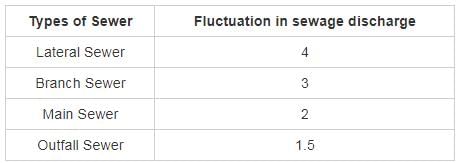

For water, the dosage at a breakpoint is 1.5 mg/L and residual chlorine at that time is found to be 0.3 mg/L. If cumulative chlorine added is 2 mg/L, the total residual chlorine will be –- a)1.2 mg/L
- b)0.8 mg/L
- c)0.5 mg/L
- d)Zero
Correct answer is option 'B'. Can you explain this answer?
For water, the dosage at a breakpoint is 1.5 mg/L and residual chlorine at that time is found to be 0.3 mg/L. If cumulative chlorine added is 2 mg/L, the total residual chlorine will be –
a)
1.2 mg/L
b)
0.8 mg/L
c)
0.5 mg/L
d)
Zero

|
Pallabi Tiwari answered |
Break point chlorination = Chlorine demand = 1.5 mg/L
Combined Cl2 residual at that time = 0.3 mg/L
Chlorine dosage = 2 mg/L
∴ Free chlorine residual = Dose – demand
= 2 – 1.5
= 0.5 mg/L
∴ Total chlorine residual = Free chlorine residual + combined chlorine residual
= 0.5 + 0.3
= 0.8 mg/L
The slope of a 1.0 m diameter concrete sewer laid at a slope of 1 in 1000, develops a velocity of 1 m/s, when flowing full. When it is flowing half – full, the velocity of flow through the sewer will be- a)0.5 m/s
- b)1.0 m/s
- c)2 m/s
- d)2.0 m/s
Correct answer is option 'B'. Can you explain this answer?
The slope of a 1.0 m diameter concrete sewer laid at a slope of 1 in 1000, develops a velocity of 1 m/s, when flowing full. When it is flowing half – full, the velocity of flow through the sewer will be
a)
0.5 m/s
b)
1.0 m/s
c)
2 m/s
d)
2.0 m/s

|
Jithin Choudhury answered |
For,

Where d is depth of flow

Where d is depth of flow
v is flow velocity at depth d
D is diameter of sewer
V is flow velocity at full flow
∴ v = 1.0 m/s
For the Sewer of size 550 mm, it is designed to run “x” times full. The value of x is- a)1/2
- b)3/4
- c)3/2
- d)2/3
Correct answer is option 'D'. Can you explain this answer?
For the Sewer of size 550 mm, it is designed to run “x” times full. The value of x is
a)
1/2
b)
3/4
c)
3/2
d)
2/3

|
Partho Jain answered |
Sewers are never designed to run at full depth. If the size of the Sewer is less than 400 mm, these are designed to run half full. If the Sewer size is in the range of 400 to 900 mm, these are designed to run 2/3rd full. When the size of Sewer is more than 900 mm, these are designed for 3/4th full.
Match the following:-
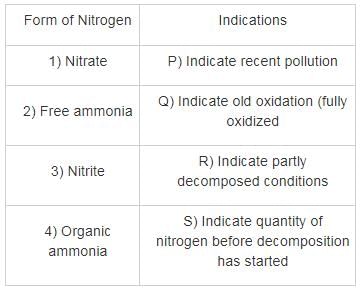
- a)1 - Q, 2 - P, 3 - S, 4 - R
- b)1 - Q, 2 - P, 3 - R, 4 - S
- c)1 - R, 2 - Q, 3 - P, 4 - S
- d)1 - R, 2 - Q, 3 - S, 4 - P
Correct answer is option 'B'. Can you explain this answer?
Match the following:-


a)
1 - Q, 2 - P, 3 - S, 4 - R
b)
1 - Q, 2 - P, 3 - R, 4 - S
c)
1 - R, 2 - Q, 3 - P, 4 - S
d)
1 - R, 2 - Q, 3 - S, 4 - P

|
Diya Dasgupta answered |
Free Ammonia – indicate recent pollution
Nitrate – indicate old pollution (fully oxidized)
Nitrite – indicate partly decomposed condition
Organic – indicate quantity of nitrogen before decomposition started.
Which of the following biological unit process is based on a suspended growth system1. Activated sludge process2. Aerated lagoon3. Rotating Biological contractors4. Aerobic and Anaerobic Digester- a)1 and 2
- b)1, 2 and 3
- c)2, 3 and 4
- d)1, 2 and 4
Correct answer is option 'D'. Can you explain this answer?
Which of the following biological unit process is based on a suspended growth system
1. Activated sludge process
2. Aerated lagoon
3. Rotating Biological contractors
4. Aerobic and Anaerobic Digester
a)
1 and 2
b)
1, 2 and 3
c)
2, 3 and 4
d)
1, 2 and 4

|
Nikhil Majumdar answered |
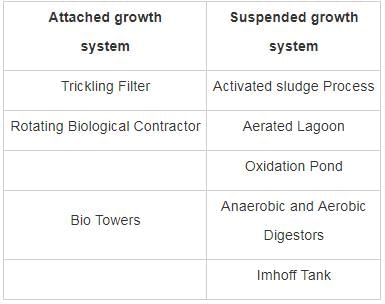
The cleaning of slow sand filter is done by –- a)reversing the direction of flow of water.
- b)passing air through the filter.
- c)passing solution of alum and lime through the filter.
- d)scrapping off top layer of sand and admitting water.
Correct answer is option 'D'. Can you explain this answer?
The cleaning of slow sand filter is done by –
a)
reversing the direction of flow of water.
b)
passing air through the filter.
c)
passing solution of alum and lime through the filter.
d)
scrapping off top layer of sand and admitting water.

|
Asha Deshpande answered |
The cleaning of slow sand filter is done by scrapping off the top sand layer and cleaning of rapid sand filter and pressure filter is done by passing air and by back - washing.
A large stream has a reoxygenation constant of 0.45 per day and at a point at which organic pollutant is discharged, it is saturated with oxygen at 12 mg/L (Do = 0). Below the outfall, the ultimate demand for oxygen is found to be 19 mg/l and the Deoxygenation Constant is 0.2 per day. Calculate, the D.O at 36 km downstream Assume velocity of the stream to be 1.2 m/s.- a)10 mg/l
- b)16.65 mg/l
- c)6.65 mg/l
- d)9.65 mg/l
Correct answer is option 'D'. Can you explain this answer?
A large stream has a reoxygenation constant of 0.45 per day and at a point at which organic pollutant is discharged, it is saturated with oxygen at 12 mg/L (Do = 0). Below the outfall, the ultimate demand for oxygen is found to be 19 mg/l and the Deoxygenation Constant is 0.2 per day. Calculate, the D.O at 36 km downstream Assume velocity of the stream to be 1.2 m/s.
a)
10 mg/l
b)
16.65 mg/l
c)
6.65 mg/l
d)
9.65 mg/l

|
Shilpa Pillai answered |
Given data:
Reoxygenation constant (k1) = 0.45 per day
Initial dissolved oxygen (Do) = 0 mg/L
Ultimate demand for oxygen (U) = 19 mg/L
Deoxygenation constant (k2) = 0.2 per day
Distance downstream (d) = 36 km = 36,000 m
Velocity of the stream (v) = 1.2 m/s
To calculate the dissolved oxygen (DO) at 36 km downstream, we need to consider the reoxygenation and deoxygenation processes in the stream.
1. Reoxygenation Process:
The reoxygenation process replenishes the dissolved oxygen in the stream. The rate of reoxygenation is given by the equation:
dDO/dt = k1 * (U - DO)
where dDO/dt is the rate of change of dissolved oxygen with respect to time.
2. Deoxygenation Process:
The deoxygenation process consumes the dissolved oxygen in the stream. The rate of deoxygenation is given by the equation:
dDO/dt = -k2 * DO
Since the stream is saturated with oxygen at the point of discharge (Do = 0), we can assume the deoxygenation process dominates initially.
3. Calculation of DO at 36 km downstream:
We can solve the differential equation for the deoxygenation process to find the dissolved oxygen at any point downstream.
Integrating the equation, we get:
ln(DO) = -k2 * t + C
where C is the integration constant.
Using the initial condition at the point of discharge (Do = 0), we can determine the integration constant C:
ln(0) = -k2 * 0 + C
C = ln(0)
C = -∞ (negative infinity)
Now, let's substitute the values and calculate the dissolved oxygen at 36 km downstream:
ln(DO) = -k2 * t - ∞
ln(DO) = -k2 * t
Solving for DO:
DO = e^(-k2 * t)
Substituting the values:
DO = e^(-0.2 * 36,000 / 1.2)
Calculating the value:
DO ≈ 9.65 mg/L
Therefore, the dissolved oxygen at 36 km downstream is approximately 9.65 mg/L.
Hence, the correct answer is option 'D'.
Reoxygenation constant (k1) = 0.45 per day
Initial dissolved oxygen (Do) = 0 mg/L
Ultimate demand for oxygen (U) = 19 mg/L
Deoxygenation constant (k2) = 0.2 per day
Distance downstream (d) = 36 km = 36,000 m
Velocity of the stream (v) = 1.2 m/s
To calculate the dissolved oxygen (DO) at 36 km downstream, we need to consider the reoxygenation and deoxygenation processes in the stream.
1. Reoxygenation Process:
The reoxygenation process replenishes the dissolved oxygen in the stream. The rate of reoxygenation is given by the equation:
dDO/dt = k1 * (U - DO)
where dDO/dt is the rate of change of dissolved oxygen with respect to time.
2. Deoxygenation Process:
The deoxygenation process consumes the dissolved oxygen in the stream. The rate of deoxygenation is given by the equation:
dDO/dt = -k2 * DO
Since the stream is saturated with oxygen at the point of discharge (Do = 0), we can assume the deoxygenation process dominates initially.
3. Calculation of DO at 36 km downstream:
We can solve the differential equation for the deoxygenation process to find the dissolved oxygen at any point downstream.
Integrating the equation, we get:
ln(DO) = -k2 * t + C
where C is the integration constant.
Using the initial condition at the point of discharge (Do = 0), we can determine the integration constant C:
ln(0) = -k2 * 0 + C
C = ln(0)
C = -∞ (negative infinity)
Now, let's substitute the values and calculate the dissolved oxygen at 36 km downstream:
ln(DO) = -k2 * t - ∞
ln(DO) = -k2 * t
Solving for DO:
DO = e^(-k2 * t)
Substituting the values:
DO = e^(-0.2 * 36,000 / 1.2)
Calculating the value:
DO ≈ 9.65 mg/L
Therefore, the dissolved oxygen at 36 km downstream is approximately 9.65 mg/L.
Hence, the correct answer is option 'D'.
A water treatment plant is required to process 50,000 m3 water per day. The rapid mixing tank will blend 50 mg/L of alum with the flow and have a detention time of 2 min. The power input (in kilowatt) necessary for a G value of 750 S-1 at water temperature 22°C is _____.(use kinematic viscosity at 22°C as 1 × 10-6 m2/s)
Correct answer is between '38.5,39.5'. Can you explain this answer?
A water treatment plant is required to process 50,000 m3 water per day. The rapid mixing tank will blend 50 mg/L of alum with the flow and have a detention time of 2 min. The power input (in kilowatt) necessary for a G value of 750 S-1 at water temperature 22°C is _____.
(use kinematic viscosity at 22°C as 1 × 10-6 m2/s)

|
Lakshmi Datta answered |
Power input (P) = μVG2
Where, μ = dynamic viscosity of water
V = volume of the tank
G = velocity gradient

P = 39.0625 kW

P = 39.0625 kW
The efficiency of sediment removal in a continuous flow sedimentation tank does not depend upon-- a)depth of the tank.
- b)discharge through the tank.
- c)length of the tank.
- d)width of the tank.
Correct answer is option 'A'. Can you explain this answer?
The efficiency of sediment removal in a continuous flow sedimentation tank does not depend upon-
a)
depth of the tank.
b)
discharge through the tank.
c)
length of the tank.
d)
width of the tank.

|
Pallabi Tiwari answered |
For particle removal, setting velocity > Surface loading rate.


Settling velocity is depended upon the particle size & SLR is on the surface area which depends on length and width.
So efficiency of particle removal does not depend upon the depth of the tank.
For a colony of 10000 persons having sewage flow rate 250 lpcd with a BOD of 320 mg/l and organic loading of 200 Kg/day/ha, the area of the oxidation pond required for treating the sewage of the colony is _______- a)3.6 hectares
- b)4 hectares
- c)4.6 hectored
- d)2 hectare
Correct answer is option 'B'. Can you explain this answer?
For a colony of 10000 persons having sewage flow rate 250 lpcd with a BOD of 320 mg/l and organic loading of 200 Kg/day/ha, the area of the oxidation pond required for treating the sewage of the colony is _______
a)
3.6 hectares
b)
4 hectares
c)
4.6 hectored
d)
2 hectare

|
Raghavendra Goyal answered |
Total BOD produced per day = 
Organic loading rate = 200 kg/day/ha


Organic loading rate = 200 kg/day/ha

Arrange the given lakes in the descending order of their productivity levelMesotrophic LakesOligotrophic LakesEutrophic Lakes- a)Mesotrophic Lakes, Oligotrophic Lakes and Eutrophic Lakes
- b)Eutrophic Lakes, Mesotrophic Lakes and Oligotrophic Lakes
- c)Oligotrophic Lakes, Eutrophic Lakes and Mesotrophic Lakes
- d)Oligotrophic Lakes, Mesotrophic Lakes and Eutrophic Lakes
Correct answer is option 'B'. Can you explain this answer?
Arrange the given lakes in the descending order of their productivity level
Mesotrophic Lakes
Oligotrophic Lakes
Eutrophic Lakes
a)
Mesotrophic Lakes, Oligotrophic Lakes and Eutrophic Lakes
b)
Eutrophic Lakes, Mesotrophic Lakes and Oligotrophic Lakes
c)
Oligotrophic Lakes, Eutrophic Lakes and Mesotrophic Lakes
d)
Oligotrophic Lakes, Mesotrophic Lakes and Eutrophic Lakes

|
Manasa Sen answered |
Eutrophic Lakes: These are the lakes of high productivity level, hence support high growth of algae.
Mesotrophic Lakes: These are the lakes of intermediate productivity level, hence support intermediate growth of algae.
Oligotrophic Lakes: These are the lakes of least productivity level, hence support negligible growth of algae.
According to the Noise Pollution (Regulation and Control) Rules, 2000, of the Ministry of Environment Forests, India, the day time and night time noise level limits in ambient air for residential area expressed in dB (A) Leq are
- a)50 and 40
- b)55 and 45
- c)65 and 55
- d)75 and 70
Correct answer is option 'B'. Can you explain this answer?
According to the Noise Pollution (Regulation and Control) Rules, 2000, of the Ministry of Environment Forests, India, the day time and night time noise level limits in ambient air for residential area expressed in dB (A) Leq are
a)
50 and 40
b)
55 and 45
c)
65 and 55
d)
75 and 70

|
Yashvi Choudhury answered |
Ambient air quality standards in respect of Noise as per Noise Pollution (Regulation and Control) Rules, 2000, of the Ministry of Environment & Forests, India are tabulated below:
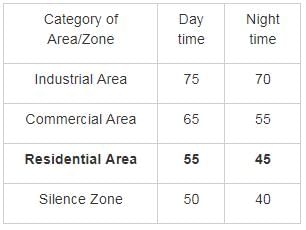

At a location three sound pressure levels were recorded as 40 dB, 50 dB, & 60 dB. The average sound pressure level is ________- a)50 dB
- b)52.15 dB
- c)53.50 dB
- d)60 dB
Correct answer is option 'C'. Can you explain this answer?
At a location three sound pressure levels were recorded as 40 dB, 50 dB, & 60 dB. The average sound pressure level is ________
a)
50 dB
b)
52.15 dB
c)
53.50 dB
d)
60 dB

|
Arnab Saini answered |
The average sound pressure level at that location is:
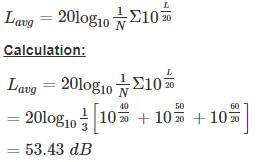

An air parcel having 40° temperature moves from ground level to 500m elevation in dry air following the “adiabatic lapse rate”. The temperature of air parcel at 500 m elevation will be- a)35°C
- b)38°C
- c)41°C
- d)44°C
Correct answer is option 'A'. Can you explain this answer?
An air parcel having 40° temperature moves from ground level to 500m elevation in dry air following the “adiabatic lapse rate”. The temperature of air parcel at 500 m elevation will be
a)
35°C
b)
38°C
c)
41°C
d)
44°C

|
Ashwin Desai answered |
Dry air cools at the rate of 9.8°C per km and it is called dry adiabatic lapse rate. In saturated (wet) air, this rate is calculated to be 6°C per km and is known as wet adiabatic lapse rate.
Resulting temperature of air
= 40 − 9.8 × 500/1000 = 40 − 4.9 = 35.1∘C
= 40 − 9.8 × 500/1000 = 40 − 4.9 = 35.1∘C
The mean indoor airborne chloroform (CHCl3) concentration in a room was determined to be 0.4 µg/m3. Use the following data:T = 293 KP = 1 atmosphereR = 82.05 × 10-6 atm.m3/mol-KAtomic weights: C = 12, H = 1, Cl = 35.5. The concentration expressed in parts per billion (volume basis, ppbv) is equal to –- a)1.00 ppbv
- b)0.20 ppbv
- c)0.10 ppbv
- d)0.08 ppbv
Correct answer is option 'D'. Can you explain this answer?
The mean indoor airborne chloroform (CHCl3) concentration in a room was determined to be 0.4 µg/m3. Use the following data:
T = 293 K
P = 1 atmosphere
R = 82.05 × 10-6 atm.m3/mol-K
Atomic weights: C = 12, H = 1, Cl = 35.5. The concentration expressed in parts per billion (volume basis, ppbv) is equal to –
a)
1.00 ppbv
b)
0.20 ppbv
c)
0.10 ppbv
d)
0.08 ppbv

|
Yashvi Choudhury answered |
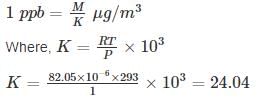
Molecular weight, M = 12 + 1 + 3 × 35.5 = 119.5

Two samples of water form two different sources are collected to measure pH value and it was found to be 6.2 and 6.8. How many times the first sample is more acidic than the second sample?- a)2
- b)4
- c)8
- d)16
Correct answer is option 'B'. Can you explain this answer?
Two samples of water form two different sources are collected to measure pH value and it was found to be 6.2 and 6.8. How many times the first sample is more acidic than the second sample?
a)
2
b)
4
c)
8
d)
16

|
Nilesh Kapoor answered |
Concept:-
pH = -log10 [H+]
-log10 [H+] = pH
[H+] = 10 -pH
Calculation
[H+]I = 10-6.2
[H+]II = 10-6.8

Hence, first sample is 4 times acidic than second sample.

Hence, first sample is 4 times acidic than second sample.
In conventional activates sludge process, the mean cell residence time in the aeration tank is–- a)Less than 1.5 hr
- b)In the range of 4 to 8 hr
- c)In the range of 12 to 24 hr
- d)In the range of 4 to 15 days
Correct answer is option 'D'. Can you explain this answer?
In conventional activates sludge process, the mean cell residence time in the aeration tank is–
a)
Less than 1.5 hr
b)
In the range of 4 to 8 hr
c)
In the range of 12 to 24 hr
d)
In the range of 4 to 15 days

|
Rounak Choudhary answered |
Typically around 5-10 days.
A sedimentation tank is treating 2 MLD of sewage per day containing 225 mg/L of suspended solids. The tank removes 30% of suspended solids. The moisture content of sludge is 98%. If the sludge is reduced to half of its volume, then the moisture content of the reduced volume sludge is –- a)92%
- b)95%
- c)94%
- d)96%
Correct answer is option 'D'. Can you explain this answer?
A sedimentation tank is treating 2 MLD of sewage per day containing 225 mg/L of suspended solids. The tank removes 30% of suspended solids. The moisture content of sludge is 98%. If the sludge is reduced to half of its volume, then the moisture content of the reduced volume sludge is –
a)
92%
b)
95%
c)
94%
d)
96%

|
Saptarshi Khanna answered |
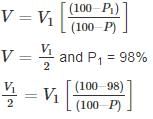
⇒ 100 – P = 2 × 2
⇒ P = 100 – 4
⇒ P = 96%
Two pipe system of providing building drainage consists of- a)One solid pipe + one waste pipe + one vent pipe + one sullage pipe
- b)One soil pipe + one waste pipe + two vent pipes
- c)Two soil pipes + two waste pipes
- d)Two soil pipes only
Correct answer is option 'B'. Can you explain this answer?
Two pipe system of providing building drainage consists of
a)
One solid pipe + one waste pipe + one vent pipe + one sullage pipe
b)
One soil pipe + one waste pipe + two vent pipes
c)
Two soil pipes + two waste pipes
d)
Two soil pipes only

|
Subhankar Khanna answered |
In this system, two sets of vertical pipes are laid, i.e., one for draining night soil, and the other for draining sullage. The pipes of the first set carrying night soil are called soil pipes, and the pipes of the second set carrying sullage from baths etc., are called sullage pipes or waste pipes. The soil pipe as well as the waste pipe, are separately ventilated by providing separate vent pipes or antisiphonage pipes.
In a city of population 2 Lakhs, the average per capita water demand is 135 L/c/day. To provide with the sewerage facilities in the town sewer is to be designed. Calculate the design discharge (m3/s) through the branch sewer if it is given that sewer is designed to carry 3 times the average discharge. Assume 80% of the water supplied in the city enters in the sewer
Correct answer is '0.75'. Can you explain this answer?
In a city of population 2 Lakhs, the average per capita water demand is 135 L/c/day. To provide with the sewerage facilities in the town sewer is to be designed. Calculate the design discharge (m3/s) through the branch sewer if it is given that sewer is designed to carry 3 times the average discharge. Assume 80% of the water supplied in the city enters in the sewer

|
Subhankar Khanna answered |
About 80% of the water supplied in the city enters in the Sewer.
Average discharge through the Sewer


QAvg = 0.25 m3/sec
QDesign = 3 × QAvg
QDesign = 3 × 0.25 = 0.75 m3/sec
QDesign = 0.75 m3/sec
Calculate the minimum velocity (m/sec) required to transport Coarse sand through a sewer of 35 cm diameter with sand particles of 0.97 mm diameter and specific gravity 2.59, and organic matter of 4.75 mm average size with a specific gravity of 1.42. The friction factor for the sewer material may be assumed as 0.04 and roughness coefficient of 0.013. Consider k = 0.05 for inorganic solids and 0.07 for organic solids.
Correct answer is between '0.48,0.56'. Can you explain this answer?
Calculate the minimum velocity (m/sec) required to transport Coarse sand through a sewer of 35 cm diameter with sand particles of 0.97 mm diameter and specific gravity 2.59, and organic matter of 4.75 mm average size with a specific gravity of 1.42. The friction factor for the sewer material may be assumed as 0.04 and roughness coefficient of 0.013. Consider k = 0.05 for inorganic solids and 0.07 for organic solids.

|
Arya Menon answered |

Where Vsc = self cleaning velocity or minimum velocity in m/sec
k = constant depend upon type of Particle present in the Sewage
f = friction factor
d = size of particle under consideration(m)
For inorganic solid i.e. Coarse sand


VSC1 = 0.389 m/sec
For organic solid


VSC2 = 0.523 m/s
Minimum velocity required will be maximum of VSC1 and VSC2
So, VSC = 0.523 m/sec
A conventional activated sludge treatment plant has to treat wastewater of 2250000 litres/day, having a five day BOD of 225 mg/l. The mixed liquor suspended solids concentration in the aeration tank is 2250 mg/l and concentration of biomass leaving the system is 22.5 g/m3. If the volume of the aeration tank is 225 m3, then the average time (in days) for which the biomass stays in the system will be
Correct answer is '10'. Can you explain this answer?
A conventional activated sludge treatment plant has to treat wastewater of 2250000 litres/day, having a five day BOD of 225 mg/l. The mixed liquor suspended solids concentration in the aeration tank is 2250 mg/l and concentration of biomass leaving the system is 22.5 g/m3. If the volume of the aeration tank is 225 m3, then the average time (in days) for which the biomass stays in the system will be

|
Ashwin Gupta answered |
The average time for which the biomass stays in the system is called sludge age




where V = volume of the tank
X = mixed liquor suspended solids concentration in the aeration tank
Qw = flow of wastewater
Xu = Biomass leaving the aeration tank per day


The effective size of the particle (D10) of filter [slow sand filter] is- a)0.25 mm
- b)0.50 mm
- c)0.11 mm
- d)0.35 mm
Correct answer is option 'A'. Can you explain this answer?
The effective size of the particle (D10) of filter [slow sand filter] is
a)
0.25 mm
b)
0.50 mm
c)
0.11 mm
d)
0.35 mm

|
Akanksha Mehta answered |
As per Government of India’s Effective size (D10) of filter for slow sand filter is in the range of (0.2 to 0.3) mm and Coefficient of uniformity for this filter media is in the range of (3 – 5)
Assuming annual travel for each vehicle to be 50000 km, the quantity of NOx produced from 200,000 vehicle with emission rate 2.5 gm/km/vehicle is- a)5000 tonnes
- b)50000 tonnes
- c)2500 tonnes
- d)25000 tonnes
Correct answer is option 'D'. Can you explain this answer?
Assuming annual travel for each vehicle to be 50000 km, the quantity of NOx produced from 200,000 vehicle with emission rate 2.5 gm/km/vehicle is
a)
5000 tonnes
b)
50000 tonnes
c)
2500 tonnes
d)
25000 tonnes

|
Rajat Sen answered |
NOx emitted by 200,000 vehicles
= 2.5 × 200,000
= 500,000 g/km
NOx produced by 200,000 vehicles for a distance of 50000 km
= 500,000 × 50000 × 10-6 tonnes
= 25000 tonnes.
The percentage of the relative stability of a test conducted for the determination of relative conductivity at 20°C when the incubation was done for 20 days is _____
Correct answer is between '99,99.02'. Can you explain this answer?
The percentage of the relative stability of a test conducted for the determination of relative conductivity at 20°C when the incubation was done for 20 days is _____

|
Rajat Patel answered |
Relative stability (Sr) at 20°C
Sr = 100 [1 − (0.794)t]
= 100 [1− (0.794)20]
= 99.01%
Sr = 100 [1 − (0.794)t]
= 100 [1− (0.794)20]
= 99.01%
Consider the following statements for Sewers1. Maximum Daily Discharge is two times average daily discharge2. Maximum Hourly Discharge is three times average daily discharge3. Minimum Daily discharge is Half of the average daily discharge4. Minimum Hourly discharge is 2/3rdof the average daily discharge.Identify the incorrect Statement?- a)(1) and (2)
- b)(2) and (3)
- c)(3) and (4)
- d)(1), (3) and (4)
Correct answer is option 'C'. Can you explain this answer?
Consider the following statements for Sewers
1. Maximum Daily Discharge is two times average daily discharge
2. Maximum Hourly Discharge is three times average daily discharge
3. Minimum Daily discharge is Half of the average daily discharge
4. Minimum Hourly discharge is 2/3rdof the average daily discharge.
Identify the incorrect Statement?
a)
(1) and (2)
b)
(2) and (3)
c)
(3) and (4)
d)
(1), (3) and (4)

|
Gowri Sharma answered |
(i) Maximum Daily discharge = 2 × Average Daily Discharge
(ii) Maximum Hourly discharge = 3 × Average Daily Discharge
(iii) Minimum Daily discharge = 2/3 × Average Daily Discharge
(iv) Minimum Hourly discharge = 1/3× Average Daily Discharge
A circular primary clarifier processes an average flow of 5005 m3/d of municipal wastewater. The overflow rate is 35 m3/m2/d. the diameter of clarifier shall be- a)10.5 m
- b)11.5 m
- c)12.5 m
- d)13.5 m
Correct answer is option 'D'. Can you explain this answer?
A circular primary clarifier processes an average flow of 5005 m3/d of municipal wastewater. The overflow rate is 35 m3/m2/d. the diameter of clarifier shall be
a)
10.5 m
b)
11.5 m
c)
12.5 m
d)
13.5 m

|
Rhea Dasgupta answered |
Area of clarifier

⇒ D = 13.5 m

⇒ D = 13.5 m
The following zones are formed in a polluted river.(1) zone of clear water(2) zone of active decomposition(3) zone of recovery(4) zone of pollutionThe correct sequence in which these zones occur progressively downstream in a polluted river is- a)4, 2, 1, 3
- b)4, 2, 3, 1
- c)2, 4, 3, 1
- d)2, 4, 1, 3
Correct answer is option 'B'. Can you explain this answer?
The following zones are formed in a polluted river.
(1) zone of clear water
(2) zone of active decomposition
(3) zone of recovery
(4) zone of pollution
The correct sequence in which these zones occur progressively downstream in a polluted river is
a)
4, 2, 1, 3
b)
4, 2, 3, 1
c)
2, 4, 3, 1
d)
2, 4, 1, 3

|
Anmol Roy answered |


Arrange the layers of the atmosphere in order of increasing heights from the surface of the earth - a)Mesosphere, Stratosphere, Thermosphere, and Troposphere
- b)Stratosphere, Troposphere, Mesosphere, Thermosphere
- c)Troposphere, Stratosphere, Mesosphere, Thermosphere
- d)Troposphere, Mesosphere, Stratosphere, Thermosphere
Correct answer is option 'C'. Can you explain this answer?
Arrange the layers of the atmosphere in order of increasing heights from the surface of the earth
a)
Mesosphere, Stratosphere, Thermosphere, and Troposphere
b)
Stratosphere, Troposphere, Mesosphere, Thermosphere
c)
Troposphere, Stratosphere, Mesosphere, Thermosphere
d)
Troposphere, Mesosphere, Stratosphere, Thermosphere

|
Bhaskar Rane answered |
The Layers of atmosphere in order of increasing heights form the surge of earth
a) Troposphere_____ 0 to 11 km _____ 15 to -56°C
b) Stratosphere _____ 11 to 50 km _____ 15 to 0.2°C
c) Mesosphere _____ 50 to 85 km _____ -02° to -92°C
d) Thermosphere _____ 85 to 500 km _____ -92° to 1200°C
Answer using the codes given below the list:-
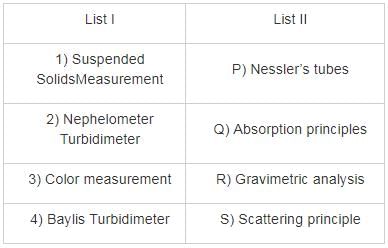
- a)1 – P, 2 – Q , 3 - S , 4 - R
- b)1 - P, 2 – Q , 3 - R , 4 - S
- c)1 - R, 2 –S , 3 - P , 4 - Q
- d)1 – R , 2 – Q , 3 – S , 4 - P
Correct answer is option 'C'. Can you explain this answer?
Answer using the codes given below the list:-


a)
1 – P, 2 – Q , 3 - S , 4 - R
b)
1 - P, 2 – Q , 3 - R , 4 - S
c)
1 - R, 2 –S , 3 - P , 4 - Q
d)
1 – R , 2 – Q , 3 – S , 4 - P

|
Kavya Mehta answered |
1) Measurement suspended solid is done by a gravimetric test involving the mass of residual measurement.
2) Measurement of Turbidity: -
A) Based on absorption principles
i) Turbidity Rod
ii) Jackson’s Turbidity meter
iii) Baylis Turbidimeter
B) Based on the scattering principle
i) Modern Nephelometer
3) Through Nessler’s tubes on Burgess scale, true colour is measured.
Chapter doubts & questions for Environmental Engineering - RRB JE for Civil Engineering 2025 is part of Civil Engineering (CE) exam preparation. The chapters have been prepared according to the Civil Engineering (CE) exam syllabus. The Chapter doubts & questions, notes, tests & MCQs are made for Civil Engineering (CE) 2025 Exam. Find important definitions, questions, notes, meanings, examples, exercises, MCQs and online tests here.
Chapter doubts & questions of Environmental Engineering - RRB JE for Civil Engineering in English & Hindi are available as part of Civil Engineering (CE) exam.
Download more important topics, notes, lectures and mock test series for Civil Engineering (CE) Exam by signing up for free.
RRB JE for Civil Engineering
2 docs|42 tests
|

Contact Support
Our team is online on weekdays between 10 AM - 7 PM
Typical reply within 3 hours
|
Free Exam Preparation
at your Fingertips!
Access Free Study Material - Test Series, Structured Courses, Free Videos & Study Notes and Prepare for Your Exam With Ease

 Join the 10M+ students on EduRev
Join the 10M+ students on EduRev
|

|
Create your account for free
OR
Forgot Password
OR
Signup to see your scores
go up
within 7 days!
within 7 days!
Takes less than 10 seconds to signup


